Home Inspections: Maintaining Downspouts and Gutters
For the past five years, as owner of Smith & Smith Home Inspections of Murfreesboro TN, houses I’ve observed that have had their gutter and downspout systems in disrepair for many years have foundation and crawl space issues, that could have easily been avoided. When it comes to maintaining your home’s condition, making sure rainwater sheds away from your home’s foundation is of the most importance. Improperly sloped and clogged gutters can also cause separation from and water damage to fascia boards, and water damage to eaves and rafter ends.
These are some of the important factors I consider when inspecting your home:
- is the guttering system adequately sized to prevent runoff;
- are the gutters free of rust, cracks and holes in order to prevent leaking; and
- do the downspouts divert water 4 to 6 feet away from the home’s foundation.
A few inches of rain falling on the roof of a house can produce several thousand gallons of water runoff. This runoff must be directed away from the home’s foundation. Otherwise, the excess water can quickly saturate the soil surrounding the building, and seep through the foundation to the interior. Once inside, this moisture can lead to a variety of problems, including mold and wood rot. Excess moisture can also cause indoor air quality problems.
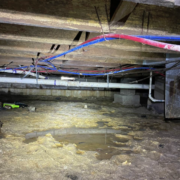
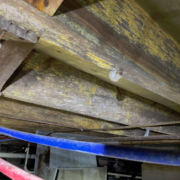
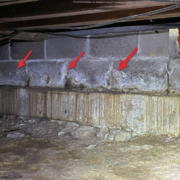
Gutter System Basics
Gutter systems consist of two parts: 1) gutter channels that run horizontally along the roof edge to collect runoff; and 2) the downspouts that carry the collected water to grade level. Roofing gutters should slope down toward the downspout at the rate of 1/16-inch per foot, or 1/4-inch per 5 to 10 feet. An angle less than this won’t allow water to move effectively, and much more of an angle will cause the water to move at too great a speed, potentially resulting in overflow over end caps and corners.
As a homeowner, in judging adequate gutter slope, look for signs of standing water in portions of the gutter away from the downspout, and eyeball the margin against the fascia.
Gutter channels are typically available in 4, 5, and 6-inch sizes. They are referred to by their shape: there are K-style gutters (also known as “ogee” because the shape resembles this molding type); and U-style gutters (or half-round). The style differences are principally aesthetic; there is no substantial difference in performance. Larger sizes conduct more water at a faster rate, provided that there are enough downspouts to drain the gutter channels without overflowing
Downspout Basics
Most downspouts are made of the same material as the gutter system, so they tend to suffer from similar problems, but with a few twists, especially in the area of mechanical damage from proximity to high-traffic areas.
Downspouts should be inspected for:
- the connection between the downspout and the gutter;
- proper attachment of the downspout to the structure;
- leakage in joints (sometimes they will have been installed upside-down);
- impact damage from doors of vehicles parked nearby; and
- downspouts that terminate onto another roof surface.
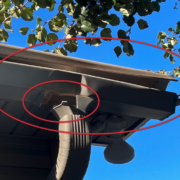
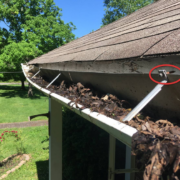
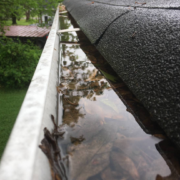
Climate
The following are some climate-specific considerations for different types of gutter systems:
- Hot-Dry and Mixed-Dry Climates: Gutters are not required in all dry climates. However, a wide roof overhang will keep occasional runoff away from the home. As with any structure, the grade at the foundation should slope away from the building. Metal, rather than vinyl, gutters and downspouts are safer in areas susceptible to wildfires.
- Hot-Humid and Mixed-Humid Climates: In areas with heavy rainfall, the gutter and rain leader capacity should be increased. Kickout and diverter flashing will prevent high water volume from spilling over the gutters and running down the exterior walls of the home.
- Marine Climate: In areas that experience high winds and heavy rains, the gutter and rain leader capacities should be increased, especially for large roofs.
- Cold and Very Cold Climates: Depending on the building codes for the jurisdiction, it may be wise to avoid the use of gutters in areas that receive high snow loads. If gutters are installed, ice buildup inside the gutters during freezing and below-freezing temperatures can lead to ice damming, which can cause moisture intrusion through the roof’s sheathing and any unsealed openings. There are products available at building supply stores that will help prevent ice dams from forming.
Tips for Homeowners
If you insist on doing the job yourself, following these tips can help you properly and safely maintain your home’s gutter system:
- Observe common-sense safety precautions (and enlist a spotter, if available) when using a ladder to reach the gutter system. Always maintain three-point contact, and don’t over-reach; move the ladder instead.
- If mounting the roof, wear footwear with gripping treads to prevent slipping. In my personal experience, I’ve discovered that skateboarding shoes have great grips for traversing roofs.
- Wear gloves to protect hands and arms from sharp debris, as well as from animals and insects that may be hiding in the gutters.
- A gutter scoop is a convenient tool for removing leaves and other debris.
- Cleaning gutters can take a substanial amount of water. Place a garden hose in the gutters and downspouts to flush them out, making sure that the water is directed away from the home via the downspouts. This will help reduce the chances of saturating the soil around the foundation.
- Covered gutter systems may be effective in preventing excessive debris buildup, but these are not maintenance-free.
- Homeowners can install a rainwater harvesting system (if allowed in their jurisdiction) that includes a drainage mechanism to handle overflow.
At Smith & Smith Home Inspections, we inspect the entire house, from the foundation to the roof, and include thermal imaging and gas leak detection, all at a reasonable, flat rate price. We provide home inspections and radon testing throughout Murfreesboro, Smyrna, Lebanon, Shelbyville, Manchester, McMinnville, La Vergne, Winchester, Woodbury, Columbia, Nashville & The Greater Middle Tennessee Area. Call/text/email to schedule your inspection today!

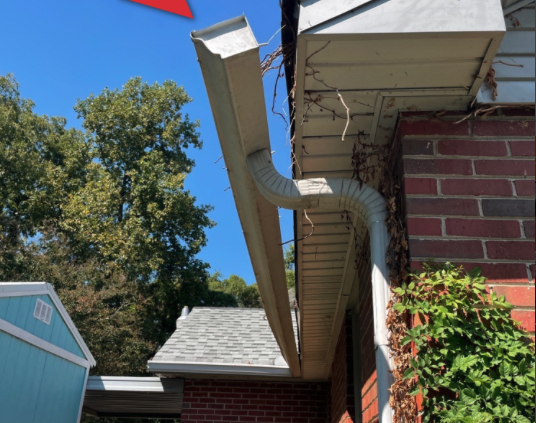


Leave a Reply
Want to join the discussion?Feel free to contribute!